Author: momo, ChainCatcher
After Hyperliquid encountered a trust crisis, the war of Perp DEXs has reignited.
Some CEXs have also begun to openly support their own ecosystem's Perp DEXs. Recently, CZ has interacted multiple times with Aster on Twitter.
The BNB Chain has long lacked a representative DEX, and amidst the chaos of Perp DEXs, CZ's support for his "favorite child" is quite evident. Aster is an exclusive investment and incubation project of YZi Labs (formerly Binance Labs) and is the leading Perp DEX on the BNB Chain.
Aster originated from the multi-asset liquidity protocol Astherus and the established derivatives exchange APX Finance. Both Astherus and APX Finance have received investment from YZi Labs. Astherus was also part of YZi Labs' seventh incubation season. In December last year, Astherus and APX Finance announced a strategic merger and recently rebranded the platform to Aster.
With the surge in popularity of Perp DEXs, Aster, backed by Binance, has also shown significant momentum recently. Along with the rebranding, Aster has undergone a major update in its product positioning and product page, and has restarted incentive programs such as trading points to attract user participation.
Recently, Aster's Perp DEX ranking briefly climbed to second place, closely following Hyperliquid.
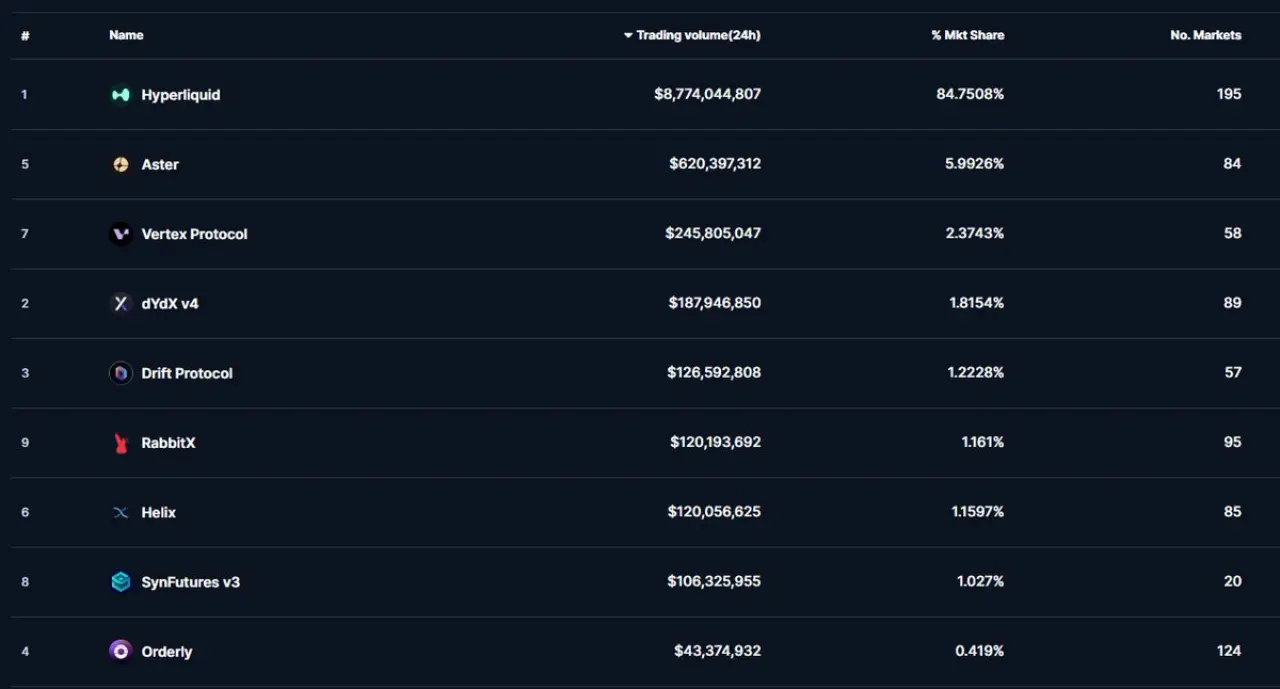
As new and old players flood in, the Perp DEX space is becoming increasingly lively, and the landscape of the on-chain derivatives market is expected to be reshaped.
Rebranding, Aster Shifts to "Perp DEX"
Aster's predecessors, Astherus and APX Finance, were originally star projects on the BNB Chain. This year, during CZ's exploration of on-chain DEXs, he frequently mentioned and pointed out these two projects.
For example, CZ tweeted about using Astherus's DEX, and in March, on-chain analyst Ai Yi monitored that CZ used BNB to long Mubarak on APX Finance.
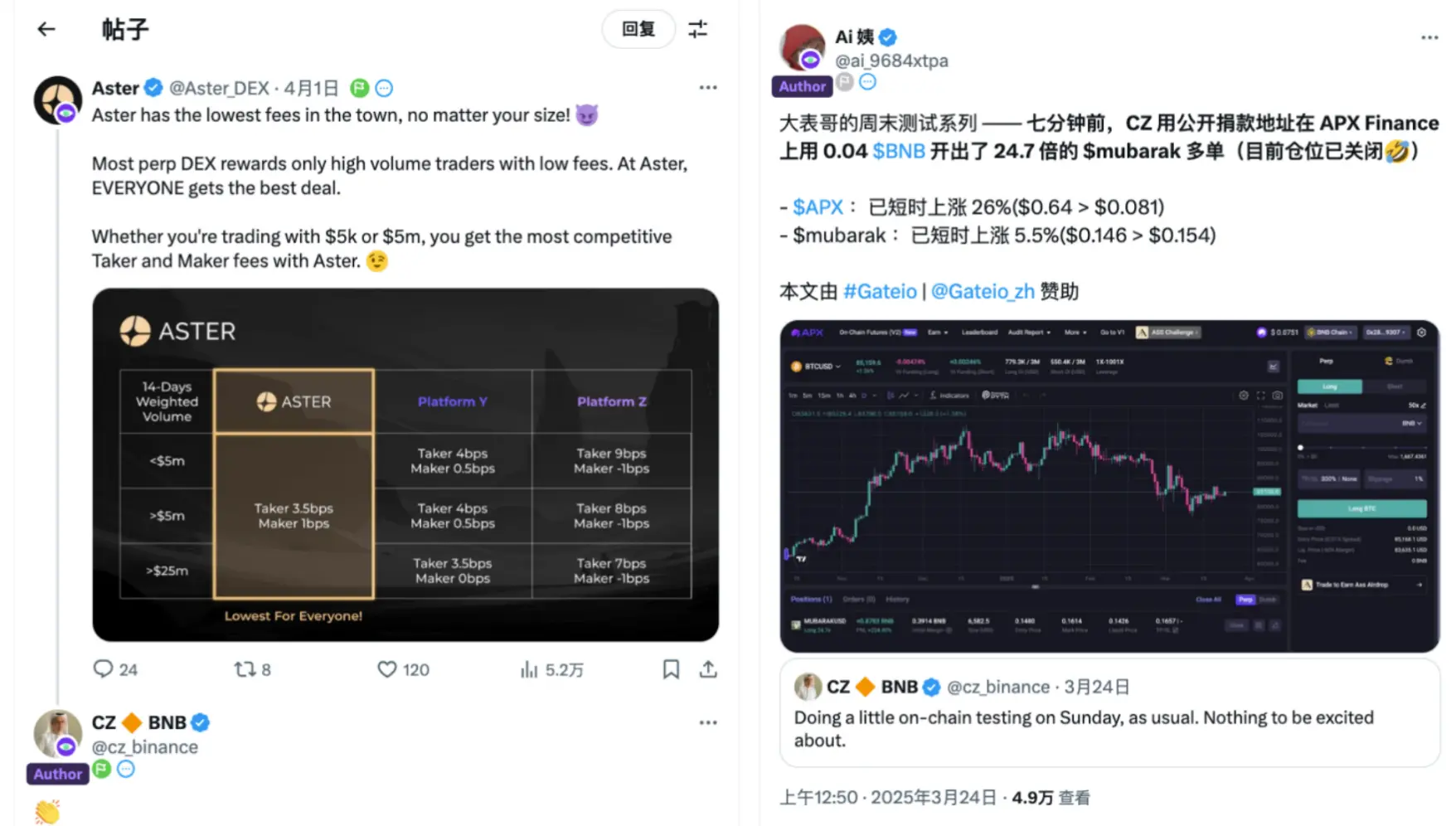
Astherus was established only last year and can be considered a dark horse on the BNB Chain. It was selected for YZi Labs' seventh incubation program in July last year and received exclusive investment from YZi Labs in November. Within just six months of its launch, Astherus's TVL exceeded $160 million and has now reached $300 million, showing rapid growth.
Astherus positioned itself as a multi-asset liquidity hub, aiming to maximize the actual returns of crypto assets. It launched several innovative products, such as the multi-strategy yield product AstherusEarn and the perpetual contract DEX AstherusEX.
On AstherusEarn, users can stake mainstream assets like BTC and BNB to earn yields, and they can also use the LST assets obtained for staking or derivatives trading to earn other DeFi yields.
By collaborating with CeFi institutions, Astherus utilizes AI-driven active yield strategy pools to generate income from both the crypto market and traditional finance, providing users with substantial real returns.
AstherusEX not only supports derivatives trading for mainstream assets like BTC but also allows for the staking and trading of assets like LST (liquid staking tokens) and LRT (liquidity yield tokens).
Additionally, Astherus's yield stablecoin USDF has opened up a second yield curve for users in DeFi.
APX Finance, on the other hand, is more established and was once the largest decentralized derivatives protocol on the BNB Chain. Its business primarily involves providing on-chain perpetual contract trading based on liquidity providers (LPs), supporting multiple chain networks including BNB Chain, Arbitrum, opBNB, and Base. APX Finance is characterized by offering users leverage of up to 1001 times, zero slippage, and lower fees.
In addition to receiving investment from YZi Labs, APX Finance has also collaborated multiple times with the Binance Web3 Wallet.
Based on optimism for the decentralized derivatives market, after Astherus and APX Finance announced their merger to become Aster, their business focus has also shifted significantly towards Perp DEX.
Product Upgrade, Dual Mode Reshaping Perp DEX
From the latest official website, Aster has undergone a major update in its UI/UX. Aster is positioned as a multi-chain, highly liquid, and secure decentralized perpetual contract platform.
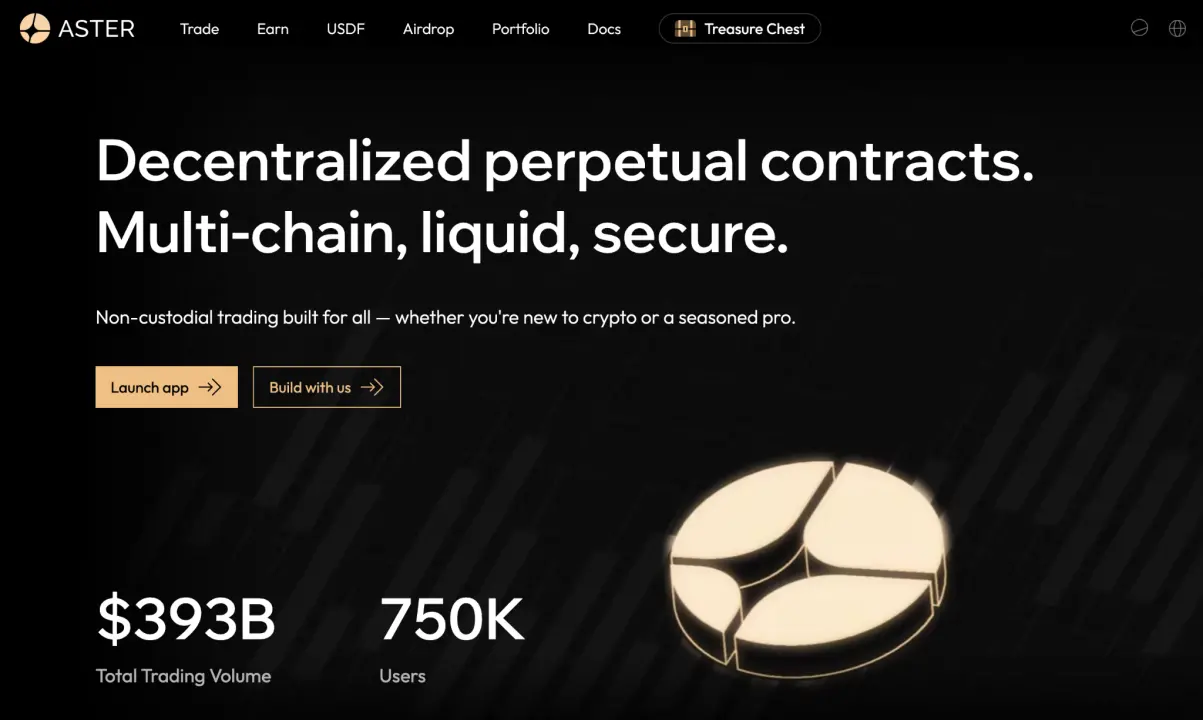
Aster has been deployed on several mainstream public chains, including BNB Chain, Arbitrum, Solana, and Ethereum.
Functionally, the "Trade" feature for perpetual contract trading is the primary focus. Additionally, Aster retains the multi-yield staking product "Earn" and the yield stablecoin USDF.
In terms of contracts, Aster introduces two trading modes: Simple and Pro.
The Simple mode is suitable for beginners and is easy to use. This mode relies on the ALP liquidity pool to ensure liquidity, supporting over 40 trading pairs of mainstream assets and popular meme coins; it allows for zero slippage opening with a maximum leverage of 1001x and no opening fees. Furthermore, the Simple mode has introduced a simpler guessing product called "dumb," further lowering the trading threshold.
The Pro mode is aimed at advanced traders. It employs an order book mechanism and supports more professional trading features such as grid trading. Users can enjoy deep liquidity and ultra-low fees (maker 0.01% / taker 0.035%) across multiple chains like BNB Chain and Arbitrum. This mode not only provides a low-cost and fast trading experience but also ensures that users manage their funds independently without needing KYC.
The dual-mode design retains the advantages of decentralized trading autonomy while providing a more precise trading experience for various users through differentiated feature settings.
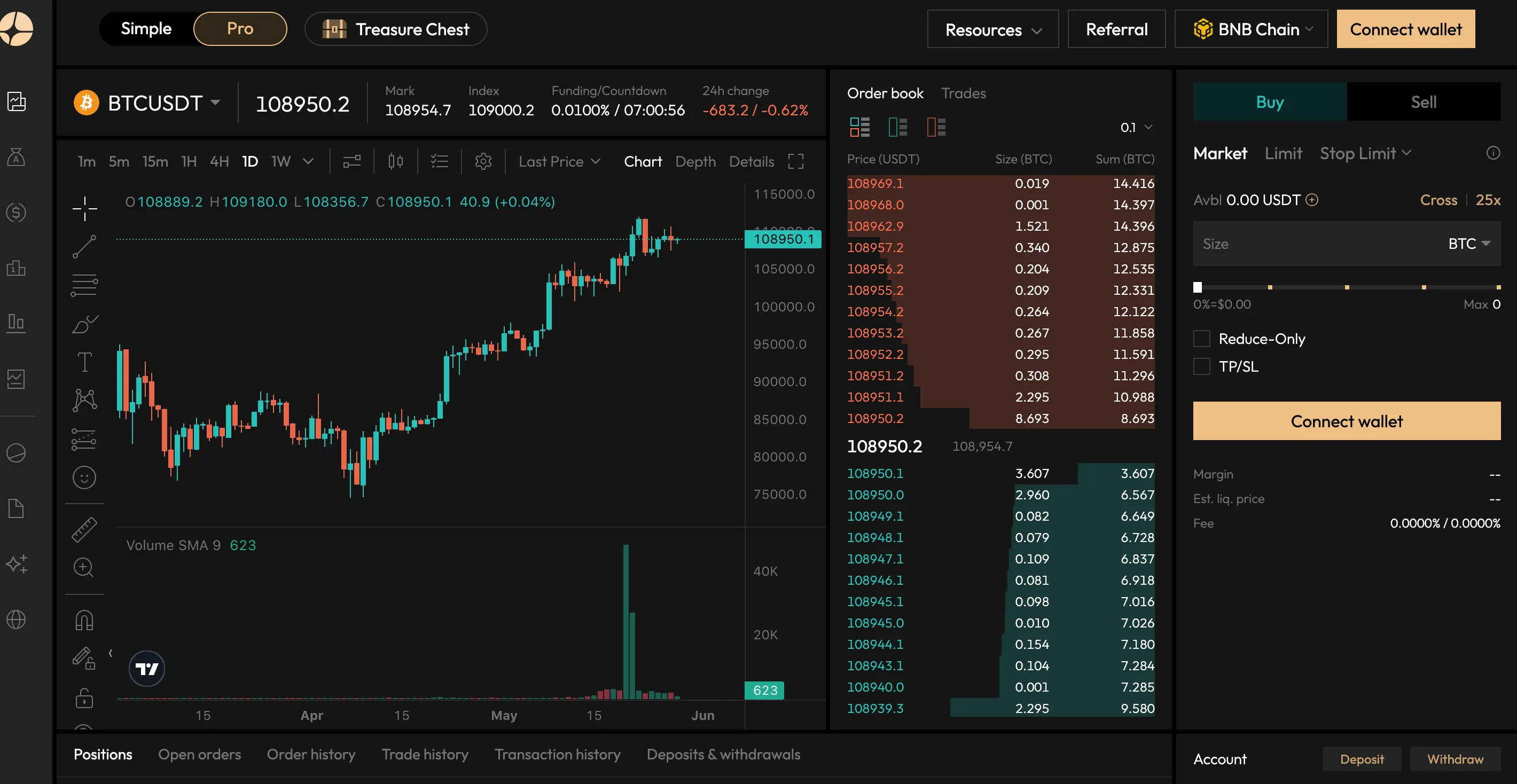
Aster states that its goal is to create a professional contract platform that combines deep liquidity, low fees, and a smooth trading experience, challenging and even surpassing Hyperliquid's position.
What Makes Aster Capable of Surpassing Hyperliquid?
As a dark horse in this cycle, Hyperliquid, despite facing a trust crisis, still possesses formidable strength. Is it possible for Aster to surpass Hyperliquid?
First, looking at the potential space of the entire Perp DEX track, Hyperliquid has indeed brought more market attention to the Perp DEX space in this cycle, but the overall warming of Perp DEXs also stems from market demand.
Compared to centralized exchanges, Perp DEXs have a better coin listing effect. Additionally, with the development of Layer 2 and multi-chain ecosystems, Perp DEXs have seen significant improvements in trading speed and user experience.
According to a CoinGecko report, the total trading volume of the top ten decentralized perpetual contract exchanges in 2024 reached $1.5 trillion, more than double the total volume in 2023.
However, despite the clear warming of decentralized perpetual contracts, they are still in the early stages of development. The total trading volume of the top ten decentralized perpetual contract exchanges in 2024 is only 2% of the total trading volume of the top ten centralized perpetual contract exchanges, indicating that the penetration rate of Perp DEXs is still low, with substantial growth potential.
The landscape of the decentralized derivatives market is still undecided, and new and old players need to innovate and optimize across multiple dimensions such as product performance, experience, and community to capture user mindshare.
What advantages does Aster have from a product perspective?
First is the lowest fees in the entire network. Aster's taker fee is only 0.03%, and the maker fee is as low as 0.01%, lower than Hyperliquid's adjusted taker fee of 0.045% (effective from April 30, 2025). Additionally, Aster has introduced a VIP tier mechanism where the larger the trading volume, the lower the fees, providing significant cost advantages for high-frequency and large-volume traders. Low fees have become a key competitive edge in attracting users, especially in high-frequency trading scenarios where cost savings are particularly evident.
Second is deep liquidity. Aster has partnered with top centralized exchanges like Binance to build a strong liquidity pool, with its bid-ask spread approaching Binance's level.
Third is product diversification. Aster's Simple and Pro modes cater to both novice and professional traders, meeting the diverse needs of different users.
Moreover, Aster's Perp DEX started with liquidity and a user base. Before the merger, Aster's yield products accumulated nearly $350 million in liquidity.
Recently, Aster's Perp DEX has also shown explosive potential. According to Defillama data, Aster's ranking has remained stable in the top five, briefly climbing to second place, closely following Hyperliquid. According to Dune panel statistics, Aster's total trading volume is about to surpass $400 billion, with a total user count of approximately 750,000 and nearly 12,000 daily trading users, indicating that the platform's trading activity is continuously rising.
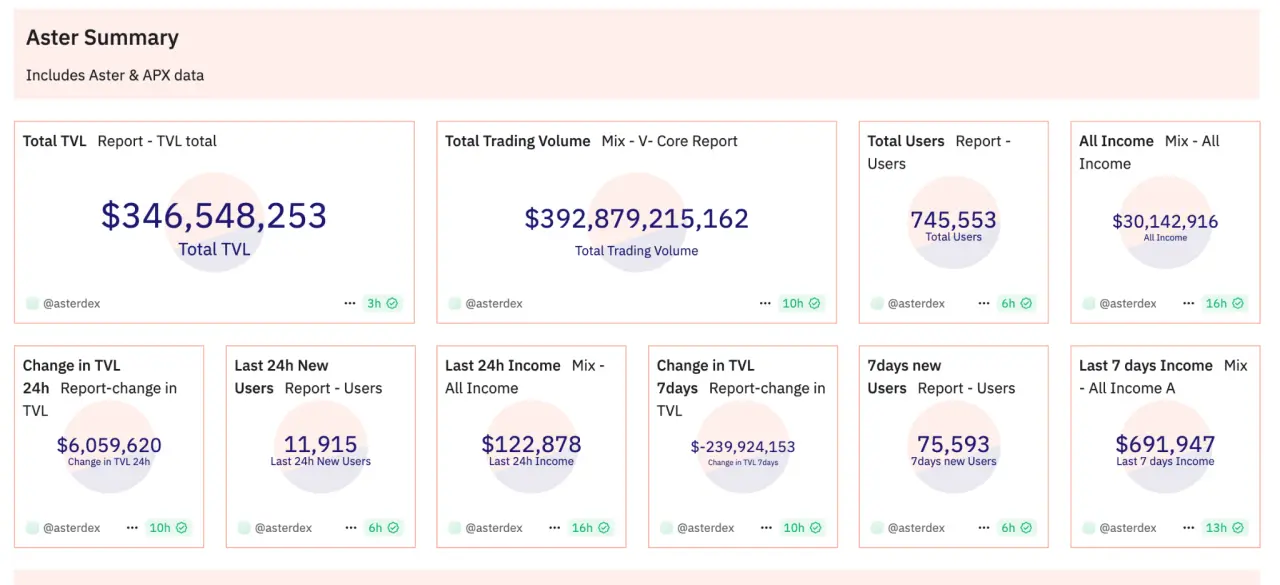
From a long-term perspective, Aster is also expanding its ecosystem products and product experience to respond to competition. According to its roadmap, it is set to launch a dedicated Layer 1, blockchain explorer, mobile app, and other enhancements to user experience and decentralization, attracting more contract users.
In terms of ecosystem, Aster is expected to benefit from the support dividends of the BNB Chain ecosystem. After Hyperliquid's rise, various public chains, especially CEX public chains, will also support their own ecosystem's DEXs to compete.
The Solana ecosystem has several phenomenal DEXs like Raydium and Jupiter, while the BNB Chain seems to lack a competitor of similar magnitude. With the rise of Perp DEXs, it is only natural for the BNB Chain to support its own invested Aster.
What Participation Opportunities Do Users Have Under Airdrop Expectations?
Amidst the surge of Perp DEXs, Aster, as a representative player invested by YZi Labs, has become a popular project for yield farmers recently.
The recently restarted trading points program by Aster may indicate that the TGE is imminent.
From the official documentation, the user incentive mechanism is currently in Stage 1: Spectra phase. Its points system is divided into two categories: Au points and Rh points, which can serve as distribution certificates for future AST airdrops.
To earn Au points, users can mint and hold Aster Earn-related assets (such as ALP, USDF, LP Token).
To earn Rh points, users primarily gain them by trading perpetual contracts using Aster's Pro mode:
By trading in Pro mode, users can earn Rh points, which can be redeemed for future $AST airdrop rewards, providing ongoing incentives for active platform supporters and traders.
Users can invite friends and form teams to collectively enjoy up to 1.2 times Rh Points bonus.
The platform has recently launched a trading activity reward of $50,000 every two weeks, providing additional bonuses on top of the points for trading.
For early participants, Aster also offers support through adjustments in trading fees and rebate plans. For instance, the recently launched VIP tier program allows users with higher trading volumes to enjoy lower expected fees; the upcoming referral rebate tier program will similarly reward referrers with higher rebate ratios based on the trading volume of their referrals.
Conclusion
Overall, as part of the Binance ecosystem, Aster has strong ecological support and advantages such as lower fees, positioning it to secure a place in the decentralized perpetual contract market. However, to replace Hyperliquid, Aster needs to continuously enhance its brand recognition, technological maturity, and market acceptance.
As the Perp DEX market continues to heat up, competition will become increasingly fierce, and the rivalry between Aster and Hyperliquid will also drive the development of the entire industry.
免责声明:本文章仅代表作者个人观点,不代表本平台的立场和观点。本文章仅供信息分享,不构成对任何人的任何投资建议。用户与作者之间的任何争议,与本平台无关。如网页中刊载的文章或图片涉及侵权,请提供相关的权利证明和身份证明发送邮件到support@aicoin.com,本平台相关工作人员将会进行核查。




